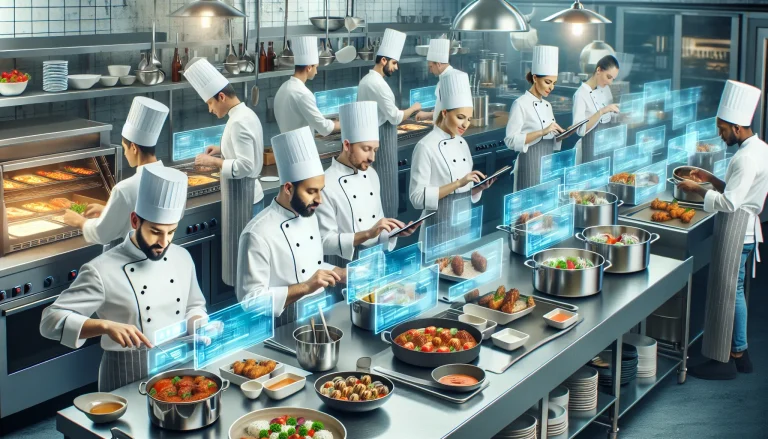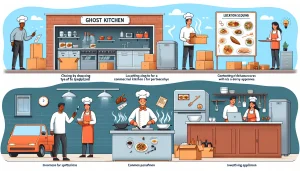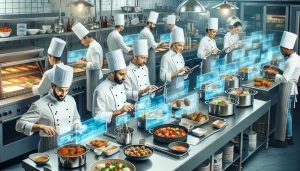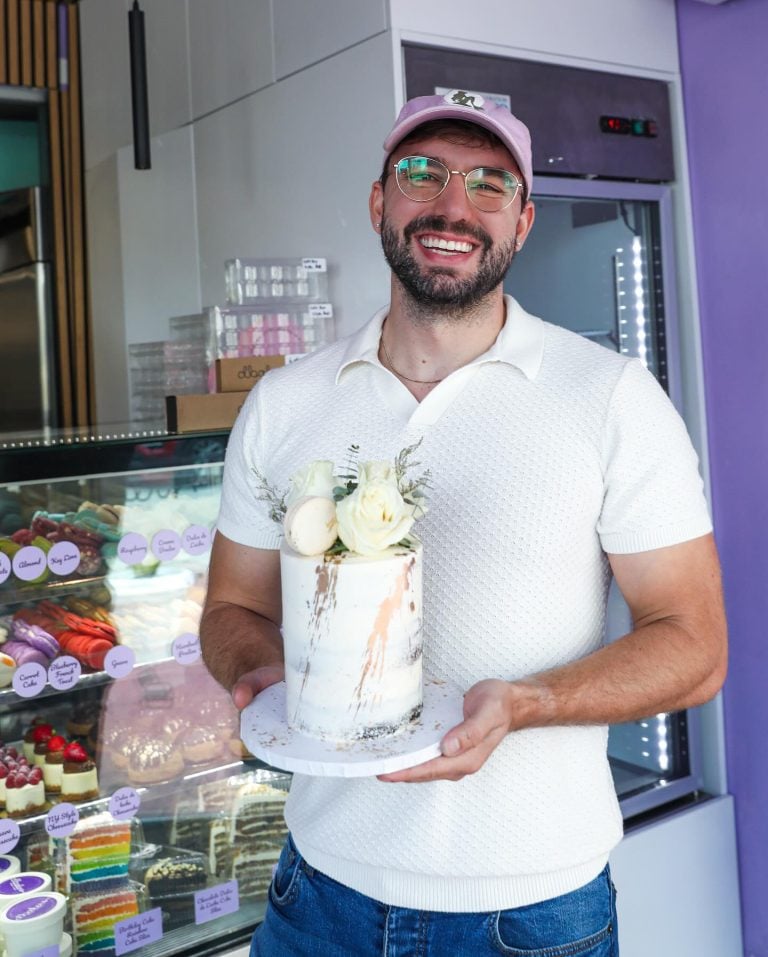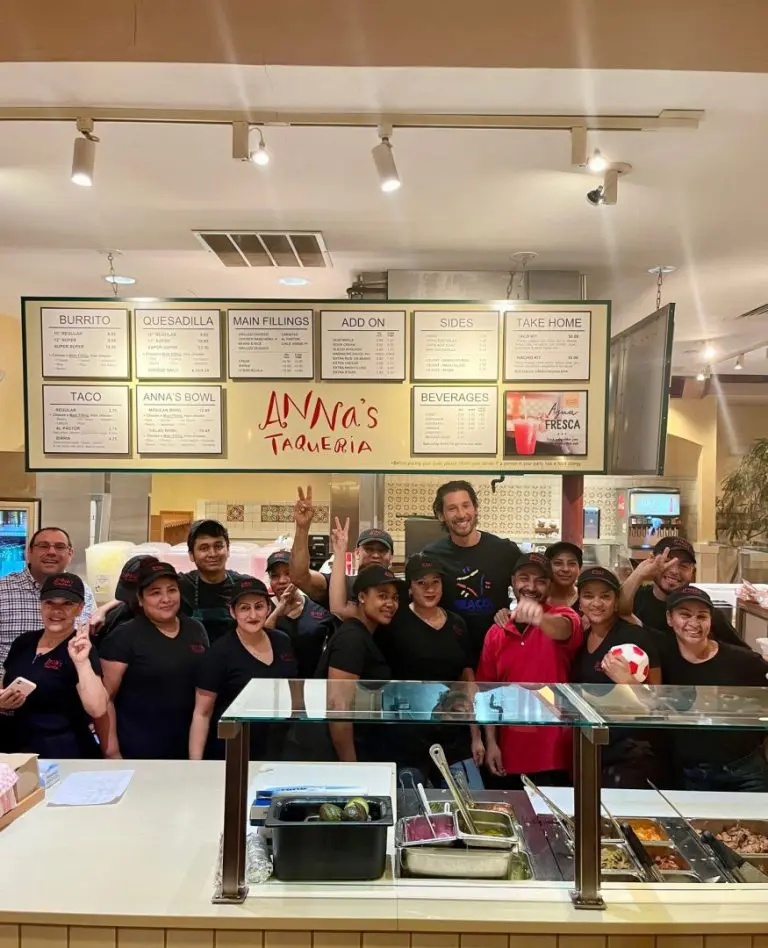Welcome to the future of dining.
Ghost Kitchens. A booming phenomenon shaking the very foundation of how we perceive and experience the dining industry. Curious about what is a ghost kitchen?
At play, we have a force potent enough to morph the restaurant business online logistics and consumer behavior. Introducing an estimated 1 million global ghost kitchens, cooking your favorite meals in concealed spots, and further invigorating the food delivery market worth around $130 billion. To put things into perspective, that’s equivalent to the GDP of Kuwait!
Let’s dig into this fascinating phenomenon, your key to unraveling the future culinary landscape.
Number of Locations:
There are approximately 1,500 ghost kitchens in the United States as of 2024.

27% higher customer satisfaction
Professional delivery features:
- Real-time GPS tracking
- Automated ETA updates
- Delivery confirmation photos
- 27% higher delivery satisfaction
Unveiling the Ghost Kitchen: A Comprehensive Understanding
Ghost kitchens are delivery-centric, virtual restaurants that have no physical dining space.
These two food service business models function on the back of strong supply chain networks and tech-enabled infrastructures.
The ghost kitchen industry is driven by major players who have introduced innovative frameworks in the delivery of ghost kitchen brands space.
Definition of a Ghost Kitchen
Ghost kitchens, also known as dark kitchens or cloud kitchens, are a new wave in the food service industry. These are virtual restaurants, exclusively designed to handle delivery orders with no physical dining space. As the notion of dining out changes swiftly, ghost kitchens have begun to gain momentum. The global pandemic has only catalyzed their popularity due to the mushrooming demand for food delivery services and takeaways. At Metrobi, we specialize in facilitating delivery for caterers, offering unmatched catering delivery solutions designed to elevate ghost kitchens’ efficiency and reach.
Ghost Kitchens as Delivery-Driven Eateries
In simple terms, a ghost kitchen is like an online restaurant operating mostly with a base kitchen and a strong online presence.
How Ghost Kitchens Operate
Ghost kitchens operate by leveraging robust supply chain networks and tech-enabled infrastructures. Essentially, these kitchens rely mainly on carryout and delivery through online platforms or proprietary apps. Metrobi supports these operations by offering delivery services across more than 20 cities in the US, including a courier service in San Francisco.
The Role of Technology
Technology is at the heart of how ghost kitchens function. Right from order processing to delivery routing, every operation is tech-driven. The use of advanced analytics and AI to forecast demand, streamline operations, and enhance the customer experience is a significant aspect of this business model.
Supply Chain Operations
Ghost kitchens rely on efficient supply chain mechanisms. This encompasses sourcing of ingredients, their storage, preparation, presentation, and delivery allocation, all the way until the food reaches the customer.
Key Players in the Ghost Kitchen Industry
To grasp the density of the ghost kitchen concept, it’s worth taking a glance at the heavyweights that are making substantial impacts in this space.
Established Entities
Prominent companies like Uber Eats, DoorDash, and Grubhub are already making strides in this market, offering shared kitchen facilities and access to various restaurants.
Emerging Ventures
Apart from these giants, numerous start-ups like CloudKitchens, Zuul, and Kitopi have launched innovative platforms catering specifically to the ghost kitchen model. They provide fully-equipped ghost kitchen work space to restaurateurs looking to switch to the delivery model or launch new brands virtually.
Ghost Kitchens' Share on US Restaurant Sales:
Ghost kitchens now make up 8.33% of U.S. restaurant sales.
Through a detailed understanding of how ghost kitchens work, it becomes apparent that they’re reshaping the food and hospitality industry’s future trajectory. As digitization continues to tread at a rapid pace, these virtual kitchens will become an integral part of the culinary world. This comprehensive understanding of ghost kitchens suits you to further explore the nitty-gritty of their sophisticated business model.

Metrobi is transforming catering deliveries
Specialized solutions for catering businesses:
- Catering-trained drivers
- Proper handling equipment
- Peak day delivery support
- 23% average cost reduction
The Ghost Kitchen Restaurant Business Model: A Game Changer in the Food Industry
Understanding the Ghost Kitchen Business Model
Ghost kitchens, also known as virtual or dark kitchens, provide a disruptive business model that could cause a paradigm shift within the food industry. With no physical dining area, these kitchens focus solely on online orders for delivery or pickup. They either deliver the food through a third party delivery apps third-party platforms or roll out their delivery service. They can house multiple brands under one roof, allowing for a more diverse menu to cater to wider demographics. Curious about launching a virtual kitchen setup? Discover the steps to initiate a ghost kitchen and make the most of this burgeoning section of the food industry.
Average Orders Per Day:
The average number of orders per day for a ghost kitchen can vary but is typically in the range of 50 to 150 orders.
Unknown to many customers, multiple restaurant brands can often operate from the same ghost kitchen. This model is advantageous not only in cost savings but also in terms of market penetration and economies of scale.
Ghost kitchens are low-risk compared to traditional restaurants. They cut costs by eliminating the need for a physical location and dining room, reducing operational costs and overhead costs. They are also conveniently located within the delivery radius of online customers, increasing accessibility. Metrobi specializes in providing delivery services for catering businesses, ensuring seamless integration and reliability in delivery operations.
Average Turnover:
The average monthly turnover for ghost kitchens can range from $50,000 to $150,000, depending on location and marketing efforts.
How Ghost Kitchen Brands Work
Ghost Kitchen brands offer great food with the convenience of online delivery. They operate from a single kitchen and have delivery drivers who deliver the food to customers. They do not have a dining room for walk-in customers. Ghost kitchen brands can be existing restaurants that are looking to add an online delivery component, or they can be new menus with menu items that are not offered by other restaurants. Metrobi supports these businesses by delivering their culinary creations to customers, offering services in over 20 US cities, including Denver, where our courier services ensure timely and reliable delivery.
Advantages of the Ghost Kitchen Model
The ghost kitchen model offers many advantages to restaurant operators and owners. It allows them to create ghost restaurants that are focused on delivery only, with all the equipment and infrastructure needed to run a kitchen. Ghost kitchens can house multiple virtual restaurant brands under one roof, offering a wider variety of menu items to customers. They can also offer local delivery within a smaller radius, increasing foot traffic to the virtual kitchen and the brick-and-mortar restaurants that they may partner with.
Why Ghost Kitchens are Cost-Effective
Ghost kitchens slash several fixed costs associated with traditional brick-and-mortar restaurants. The absence of a physical dining space eliminates exorbitant real estate leases, while reduced manpower for hosts, waitstaff, and cleaners significantly lowers wage expenses. These cost savings can then be funneled back into food quality or marketing efforts to widen customer reach and enhance delivery capabilities.
With advanced technology integration, ghost kitchens can also leverage predictive analytics to stock intelligently, reducing food waste and further cutting expenses.
The Power of Predictive Analytics in Cost Management
Keeping inventory under control is a constant challenge for traditional food establishments. However, ghost kitchens, with their data-driven strategies, can accurately forecast demand, preventing overstocking and reducing waste.
How Ghost Kitchens Cater to the On-Demand Economy
The significantly lower operational costs of ghost kitchens provide an opportunity for higher profits and competitive pricing, an attractive proposition for the on-demand food delivery market. With the rise of food delivery apps and a shift towards online food ordering, ghost kitchens have found a ripe market ready for takeover.
Interestingly, ghost kitchens not only cater to individual customer orders but can also serve large orders for corporate offices, events, or parties, opening up a new profitability channel otherwise difficult for conventional restaurants.
Ghost Kitchens and Large-Scale Catering
While regular restaurants often struggle with fluctuating large-scale orders, ghost kitchens, with their flexible infrastructure, adapt with relative ease. They can quickly scale operations to accommodate large orders without disrupting regular service, a feat unattainable for most traditional dining venues.
Operating Days per Month:
The number of operating days per month for a ghost kitchen can vary but is typically around 20 to 30 days.
Ghost Kitchen vs Traditional Brick And Mortar Restaurant: A Comparative Analysis
Operational Differences between Ghost Kitchens and Traditional Restaurants
A deep understanding of the operational variances between ghost kitchens and conventional dine-in restaurants is crucial for potential investors and restaurant owners. Of paramount importance in traditional restaurants rests on its location, ambiance, customer service, and product quality. On the other hand, ghost kitchens pivot on efficient digital interfaces, delivery speed, product quality, and consistency.
Rent Costs:
Ghost kitchens can operate with 20-40% lower rent costs compared to traditional restaurants.
Safety and meeting regulatory compliance remain steadfast in both models, however, dine-in restaurants require meticulous attention to a broader set of hygiene and comfort standards to ensure a seamless and pleasurable in-house dining experience. Ghost kitchens signify a paradigm shift in the food industry, transforming from being an experience-centered sector to a convenience-focused economy.
Labor Costs:
Ghost kitchens are estimated to save 25% on labor costs compared to traditional restaurants.
The Role of Technology in Operations
Understanding the role of technology in the operations of both ghost restaurant types is essential. Traditional restaurants rely on reservation systems, Point of Sale (POS) systems, and a handful of other software for their operations. Ghost kitchens, however, lean heavily on delivery apps, cloud kitchen software, and data analytics tools to ensure efficient dispatching and delivery of orders.
Cost Comparison: Ghost Kitchen vs Traditional Restaurant
Evaluating the cost metrics between ghost kitchens and conventional restaurants can play a pivotal role in investment decisions. The capital expenditure on real estate, décor, furniture, utilities, and staff drastically drops in a ghost kitchen setting, while the focus shifts to investing in robust technology infrastructure and delivery logistics. A comprehensive analysis of fixed costs, operating expenses, and potential profits reveals a significant competitive edge for the Ghost Kitchen model, given the scalability it offers.
Profit Margins:
The average profit margin for ghost kitchens can range from 15% to 25% of total revenue.
The average restaurant profit margin typically ranges between 3% and 5%.
Breakdown of Costs
To make an informed investment decision, breaking down the costs of running a traditional restaurant versus a ghost kitchen is crucial. The former bears the added operational costs such as rent, utilities, maintenance, staffing, and marketing to name a few, whereas the latter has minimal overheads and primarily focuses on food production costs and digital marketing techniques.
Average Order Value:
The average order value for a ghost kitchen can vary but is typically in the range of $15 to $30.
Customer Experience: Ghost Kitchen vs Traditional Restaurant
The efficiency of order delivery and the consistency in food quality define the customer experience in a ghost kitchen. Key priorities include an online user interface, real-time updates for customers, multi-brand menus to offer a variety, and the algorithm-driven approach to personalize menu offerings. Despite no face-to-face interaction with customers, ghost kitchens are in a unique position to customize and enhance the ordering process, leveraging data analytics. Traditional restaurants, with their dedicated customer service and ambiance, offer an experience that their virtual counterparts can’t. Considered an intangible selling point, this characterizes the significant divide between the two restaurant types.
The Demand for Customization
Curating a unique and personalized experience for customers has been a long-standing pursuit of traditional restaurants. Ghost kitchens, with their data-driven approach, can address this in a more streamlined way, using the collected insights to customize menus and promotions.
How to Start a Ghost Kitchen: A Step-by-Step Guide
Step 1: Market Research and Concept Development
Ghost kitchens are niche-focused, hence, the need for targeted market research and a well-defined concept.
You must understand the market demographics, prevailing trends, and your potential competitors. Market research tools can generate crucial data to guide your decisions. The concept development phase will help you define your unique selling proposition, identify a target audience, and plan a tailored menu.
The Importance of a Unique Selling Proposition
Your unique selling proposition (USP) sets you apart from competitors. Whether it’s unique recipes or memorable branding, your USP should resonate with your target audience.
Step 2: Finding the Right Location
Successful ghost kitchens are not solely reliant on foot traffic like a traditional restaurant; instead, think of it as ‘click traffic’. A strategically positioned kitchen near populated residential areas can maximize potential delivery orders. Collaboration with a shared kitchen space could also be an economical option.
The Power of Shared Kitchen Spaces
Shared kitchen spaces can reduce your initial investment cost, speed up the launch process, and simplify the licensing procedures. This sharing economy within the culinary world has made it easier for blossoming food entrepreneurs to reach hungry customers.
Ghost Kitchens Occupy 67% of London Space:
67% of available kitchen space in London is used by ghost kitchens.
Step 3: Licensing and Compliance
Operating a ghost kitchen requires certain licenses and adherence to health and safety regulations. The specific requirements vary by location, so ensure thorough research in your local jurisdiction.
Health and Safety in the Digital Dining World
While your kitchen doesn’t welcome walk-in customers, your adherence to health and safety regulations is fundamentally important. It protects your staff and ensures that customers are receiving food prepared under strict hygienic conditions.
Step 4: Setting Up the Kitchen
Equipment selection and layout design play a vital role in your kitchen’s efficiency. Opt for high-quality, compact equipment that maximizes kitchen space utilization. Investing in a robust back-end technology setup is essential to manage order influx from multiple delivery platforms.
Initial Investment:
The initial investment to start a ghost kitchen can vary but can range from $10,000 to $100,000.
The Backbone of the Ghost Kitchen – Technology
Your technology setup should integrate seamlessly with various delivery platforms, handle payments, manage orders, and support your marketing initiatives. A solid IT infrastructure will offer you a stable capacity to manage operations smoothly.
Step 5: Partnering with Delivery Platforms
Partnering with delivery platforms exposes your ghost kitchen to a vast pool of potential customers. This will increase your operational reach and consequently, your potential profits.
Navigating the Delivery Landscape
While prominent delivery platforms may demand significant commissions, the operational reach they offer is unparalleled. It’s a trade-off that’s usually worth making for most new ghost kitchens.
Pandemic Surged Delivery App Downloads:
COVID-19 drove a 150% surge in delivery app downloads, fueling ghost kitchen growth.
Step 6: Marketing and Launch
Finally, a well-crafted marketing strategy can drive your success. Utilize digital marketing, and local SEO and engage with customers on social media platforms. Lastly, plan a launch that creates buzz and instills excitement among potential customers.
The Launch: Your First Impression
A successful launch brings you immediately into the spotlight. It should be a meticulously planned event that creatively captures the essence of your brand while delivering on the promise of great taste and seamless service.
By following these steps, your ghost kitchen can carve a niche in this digital dining landscape.
Current Trends in the Ghost Kitchen Industry
Ghost kitchens, or virtual kitchens, are drastically altering the face of the current food industry. These digital-first, brick-and-mortar-last models allow for minimalist spaces, solely focused on food production without the need for a dining area. Dive into the leading virtual kitchen business structures that are shaping the future, and learn about the dynamic approaches that are fueling their rapid expansion in the food industry.
Global Online Food Delivery Market:
The global online food delivery market is projected to reach $365 billion by 2030.
Predicted Growth of Ghost Kitchens
The demand for ghost kitchens is not expected to plateau anytime soon. Experts expect a surge in this domain, owing to increasing urbanization, a rise in digitalization, and advancements in logistics and delivery operations.
Forecasted Market Size
Industry forecasts predict the ghost kitchen market to surpass tens of billions in revenue in the next few years. The potential remains vast, given the still untapped areas and the steady increase in convenience-seeking digital consumers.
Ghost Kitchen Market Value:
The ghost kitchen market was valued at $43.1 billion in 2020 and is growing at a CAGR of 11.42% from 2022 to 2030.
The Role of Technology in Ghost Kitchens
The Use of AI and Analytics
Technology plays a critical role in boosting the operations of ghost kitchens. The use of Artificial Intelligence and data analytics helps them to analyze ordering patterns, optimize delivery routes, and predict customer preferences.
Delivery Apps
Online food delivery applications act as a primary channel connecting consumers to ghost kitchens, thus eliminating the need for traditional dine-in options. Just order your desired meal, and it’ll arrive at your doorstep.
Peeling Back the Layers of Ghost Kitchens
Ghost kitchens are transforming the culinary landscape by shifting dining experiences online, reducing overhead costs, and expanding culinary choices.
This isn’t just the trend of the hour; it’s a seismic shift in the very bedrock of the industry. Understanding and embracing this change can be the difference between thriving or barely surviving in the relentlessly competitive food business.
As a player in the culinary realm, you’re poised at the precipice of this incredible opportunity. What’s holding you back? Start exploring potential partnerships for your business today, scout for ideal locations, draft kitchen plans, and study what your competitors are doing.
A question to ponder – How can adapting to ghost kitchen-style operations reinforce your brand’s promise to your valued customers?
Remember, the future belongs to those who are adept at seizing the opportunities brought about by change. In this context, ghost kitchens are that silver platter of opportunity. Seize it and lead your culinary venture into the future.

